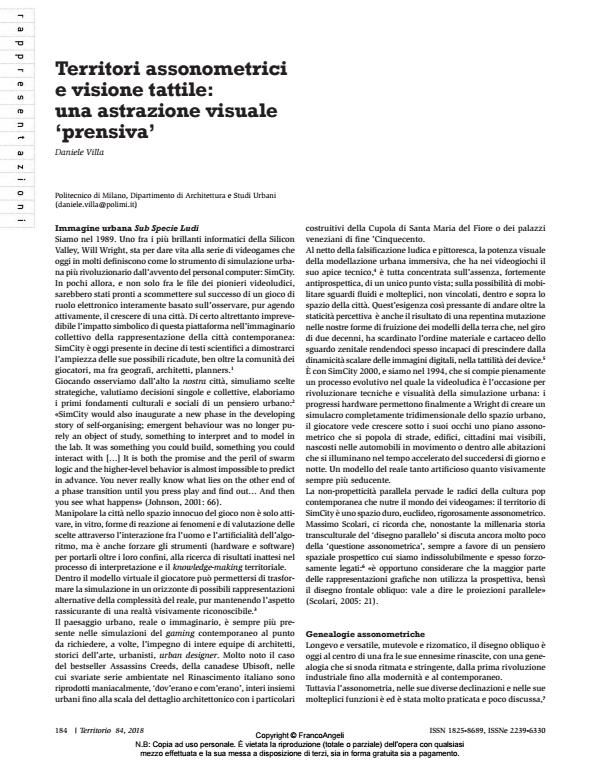Territori assonometrici e visione tattile: una astrazione visuale ‘prensiva’
Titolo Rivista TERRITORIO
Autori/Curatori Daniele Villa
Anno di pubblicazione 2018 Fascicolo 2018/84 Lingua Italiano
Numero pagine 9 P. 184-192 Dimensione file 877 KB
DOI 10.3280/TR2018-084029
Il DOI è il codice a barre della proprietà intellettuale: per saperne di più
clicca qui
Qui sotto puoi vedere in anteprima la prima pagina di questo articolo.
Se questo articolo ti interessa, lo puoi acquistare (e scaricare in formato pdf) seguendo le facili indicazioni per acquistare il download credit. Acquista Download Credits per scaricare questo Articolo in formato PDF

FrancoAngeli è membro della Publishers International Linking Association, Inc (PILA)associazione indipendente e non profit per facilitare (attraverso i servizi tecnologici implementati da CrossRef.org) l’accesso degli studiosi ai contenuti digitali nelle pubblicazioni professionali e scientifiche
- Allen S., 2008, Practice: Architecture, Technique and Representation. London: Routledge.
- Baculo Giusti A., 1992, Napoli in assonometria. Napoli: Electa.
- Batty M., Torrens P. M., 2001, «Modelling Complexity: The Limits to Prediction», Cybergeo: European Journal of Geography, 201(online)
- Bois Y.-A., 1981, «Metamorphosis of Axonometry». Daidalos, 1: 41-58.
- Bragdon C., 1932, The Frozen Fountain. New York: Knopf.
- Deleuze G., Guattari F., 1980, Mille plateaux: Capitalisme et schizophrénie. Paris: Les Editions de Minuit (trad. it., 2003, Millepiani capitalismo e schizofrenia. Roma: Cooper).
- El Lissitzky, 1925, «K. und pangeometrie». Europa-Almanach.
- Farinelli F., 2003, Geografia. Un’introduzione ai modelli del mondo. Torino: Einaudi
- Gordon E., Koo G., 2008, «Placeworlds: using virtual worlds to foster civic engagement». Space and Culture, 11: 204-221. DOI: 10.1177/1206331208319743
- Hertz D., 2016, «What Computer Games Taught Me About Urban Planning». The Atlantic. www.theatlantic.com/business/archive/2016/02/urban-planning-computer-games/470895/ (ultimo accesso: 2017.12.20).
- Huizinga J., 1939, Homo Ludens, Amsterdam: Pantheon (trad. it., 1946-2002, Homo Ludens, Torino: Einaudi).
- Johnson S., 2001, Emergence: The Connected Lives of Ants, Brains, Cities, and Software. New York: Scribner.
- Marks L.U., 2004, «Haptic Visuality: Touching with the Eyes». Framework. The Finnish Art Review, 2: 81-84.
- Nesson R., Nesson C., 2008, «The case for education in virtual worlds». Space and Culture, 11: 273-284. DOI: 10.1177/1206331208319149
- Perez-Gomez A., Pelletier L., 2000, Architectural Representation and the Perspective Hinge. Boston: mit Press.
- Riegl A., 1901, Die spätrömische Kunstindustrie nach den Funden in Österreich. Wien.
- Rufat S., Ter Minassian H., «Video games and urban simulation: new tools or new tricks?», Cybergeo: European Journal of Geography [online], Science et Toile, 622.
- Salerno R., 2000, La Macchina del Disegno. Bologna: clueb.
- Scolari M., 2005, Il disegno obliquo una storia dell’antiprospettivia, Venezia: Marsilio.
- Taussig M., 1993, Mimesis and Alterity. A Particular History of the Senses. New York, London: Routledge.
- Ugo V., 1984, Fondamenti della rappresentazione architettonica. Bologna: Esculapio.
Daniele Villa, Territori assonometrici e visione tattile: una astrazione visuale ‘prensiva’ in "TERRITORIO" 84/2018, pp 184-192, DOI: 10.3280/TR2018-084029